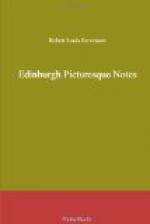CHAPTER II. OLD TOWN — THE LANDS.
The Old Town, it is pretended, is the chief characteristic, and, from a picturesque point of view, the liver-wing of Edinburgh. It is one of the most common forms of depreciation to throw cold water on the whole by adroit over-commendation of a part, since everything worth judging, whether it be a man, a work of art, or only a fine city, must be judged upon its merits as a whole. The Old Town depends for much of its effect on the new quarters that lie around it, on the sufficiency of its situation, and on the hills that back it up. If you were to set it somewhere else by itself, it would look remarkably like Stirling in a bolder and loftier edition. The point is to see this embellished Stirling planted in the midst of a large, active, and fantastic modern city; for there the two re-act in a picturesque sense, and the one is the making of the other.
The Old Town occupies a sloping ridge or tail of diluvial matter, protected, in some subsidence of the waters, by the Castle cliffs which fortify it to the west. On the one side of it and the other the new towns of the south and of the north occupy their lower, broader, and more gentle hill-tops. Thus, the quarter of the Castle over-tops the whole city and keeps an open view to sea and land. It dominates for miles on every side; and people on the decks of ships, or ploughing in quiet country places over in Fife, can see the banner on the Castle battlements, and the smoke of the Old Town blowing abroad over the subjacent country. A city that is set upon a hill. It was, I suppose, from this distant aspect that she got her nickname of auld Reekie. Perhaps it was given her by people who had never crossed her doors: day after day, from their various rustic Pisgahs, they had seen the pile of building on the hill-top, and the long plume of smoke over the plain; so it appeared to them; so it had appeared to their fathers tilling the same field; and as that was all they knew of the place, it could be all expressed in these two words.




